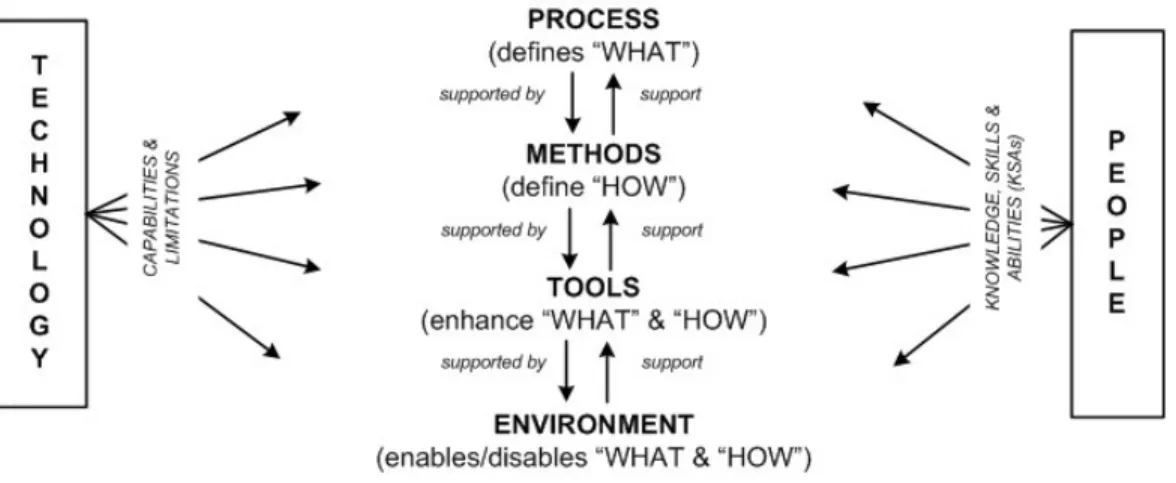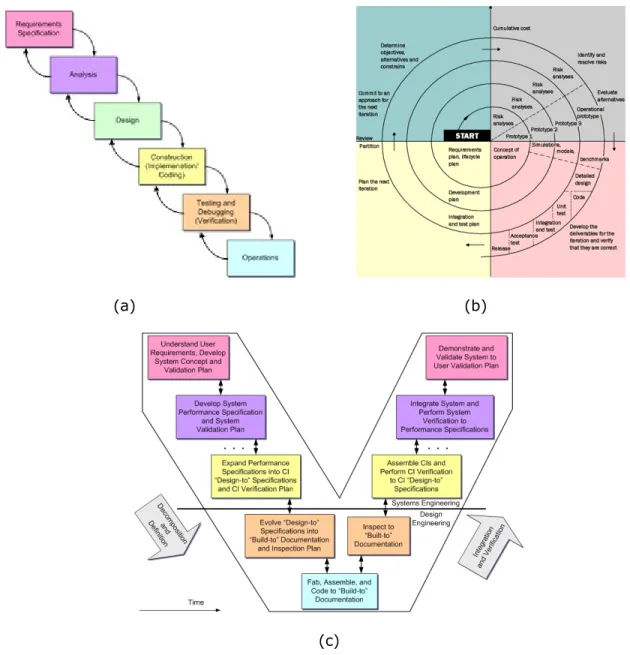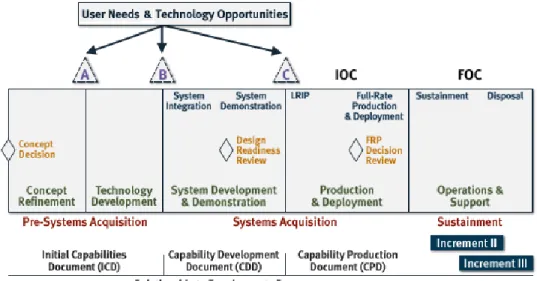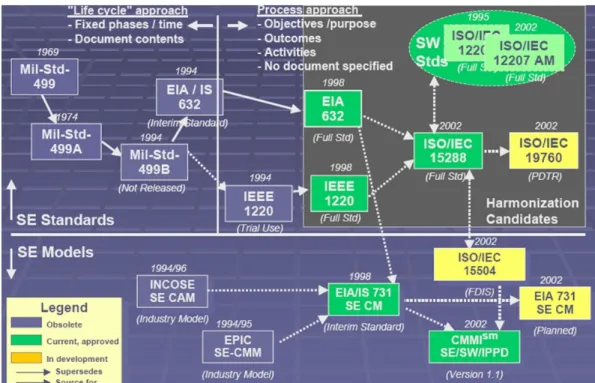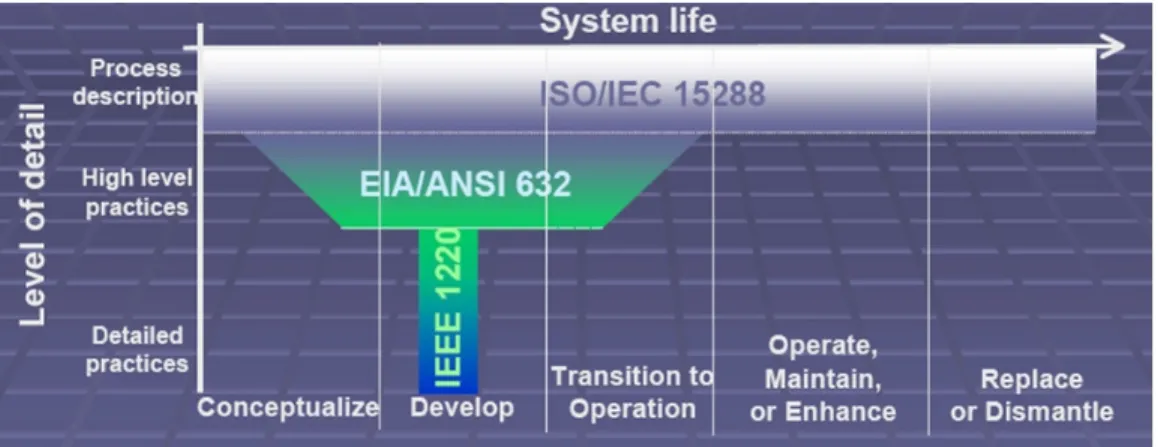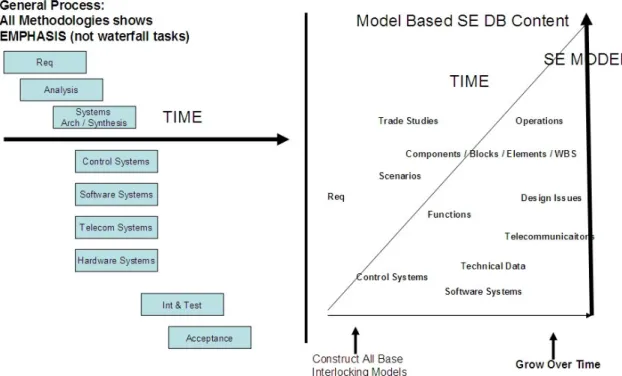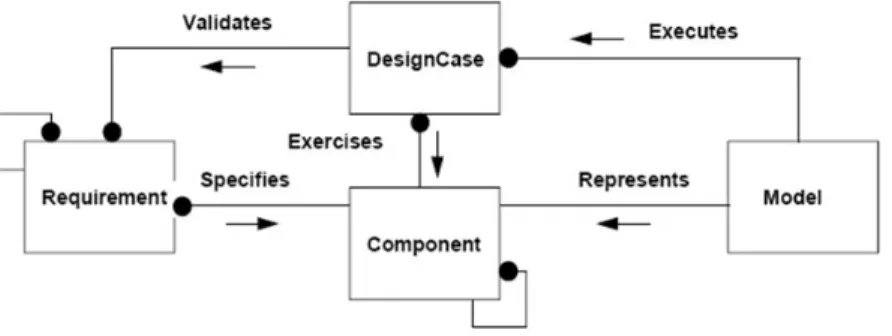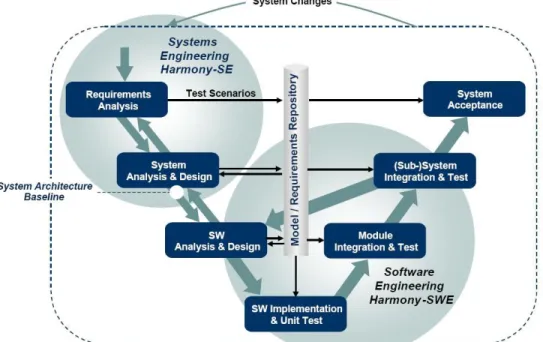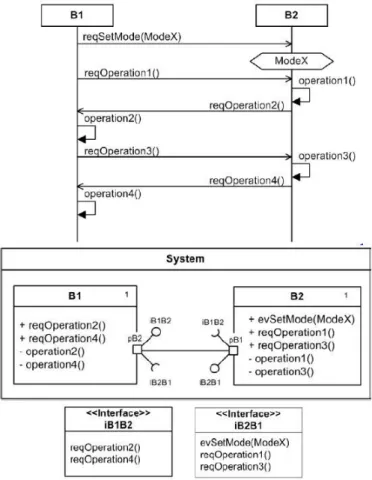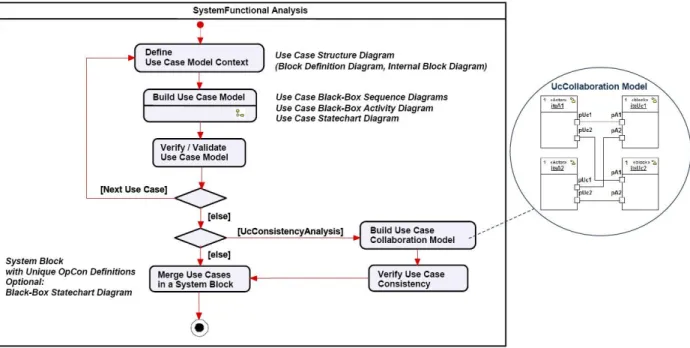Survey of Model-Based Systems Engineering (MBSE) Methodologies
Jeff A. Estefan Jet Propulsion Laboratory California Institute of Technology
Pasadena, California, U.S.A.
Jeffrey.A.Estefan@jpl.nasa.gov
1. Introduction
1.1 Purpose
The purpose of this report is to provide a cursory description of some of the leading Model- Based Systems Engineering (MBSE) methodologies used in industry today. It is intended that the material described herein provides a direct response to the INCOSE MBSE Roadmap element for a “Catalog of MBSE lifecycle methodologies.”
In this report, a methodology is defined as a collection of related processes, methods, and tools [1]. A MBSE methodology can be characterized as the collection of related processes, methods, and tools used to support the discipline of systems engineering in a “model- based” or “model-driven” context. The intent of this survey is to educate the reader—
principally, members of the INCOSE MBSE Focus Group—about the various candidate MBSE methodologies that are commercially available as well as the control- and state-based MBSE methodology that has been developed at NASA’s Jet Propulsion Laboratory (JPL), which has been published in the open literature.
1.2 Scope
This memo describes the result of a MBSE methodology survey only; it is not a methodology assessment. The material contained herein is expected to be reviewed and shared by the INCOSE MBSE Focus Group and its governing leaders. It should be noted that this is a cursory survey and only the top-level synopses of each candidate methodology is described.
Detailed descriptions of each can be found in the cited references.
As will be described, tools are an important element of any MBSE methodology; however, a survey of MBSE tools is beyond the scope of this report. It is expected that during an organization’s candidate MBSE methodology assessment process (including impact to native processes and procedures), a tool survey and assessment will occur concurrently or shortly thereafter, followed by selection and piloting of relevant tools. This latter effort requires participation from the organization’s systems engineering practitioner community because that is the community that will most heavily be using the tools.
It is intended that this report be a living document and updated on a periodic basis based on feedback and input by members of the INCOSE community at large.
1.3 Overview
This memo is organized as follows: Section 2 characterizes the difference between methodologies and processes, methods, and lifecycle models (development, acquisition, and
Survey of Candidate Model-Based Engineering (MBSE) Methodologies Page 2 of 47 systems engineering). Also described is the role of models in the systems engineering process. Section 3 documents the survey results of leading MBSE methodologies used in industry. Section 4 describes the role of the Object Management Group™ (OMG™) Unified Modeling Language™ (UML®) and Systems Modeling Language™ (OMG SysML™), which are industry-standard, visual modeling languages used to support the disciplines of software and systems engineering, and how these modeling standards relate to MBSE methodologies.
Section 5 provides a list of references used in preparation of this survey report and for the benefit of the reader. Finally, Section 6 provides a list of acronyms and abbreviations used in this report.
2. Differentiating Methodologies from Processes, Methods, and Lifecycle Models
In order to better understand key features of the various leading MBSE methodologies surveyed in this study, it is critically important to establish the terminology associated with processes, methods, and methodology, and to acknowledge the myriad lifecycle models used in the acquisition and development of large-scale, complex systems. Without such grounding, it will be extremely difficult to map any assessment and selection of candidate MBSE methodologies into the fabric of the systems engineering environment within a particular organization.
2.1 Process, Method, Tool, Methodology, and Environment Defined
The word methodology is often erroneously considered synonymous with the word process.
For purposes of this study, the following definitions from Martin [1] are used to distinguish methodology from process, methods, and tools:
A Process (P) is a logical sequence of tasks performed to achieve a particular objective. A process defines “WHAT” is to be done, without specifying “HOW” each task is performed. The structure of a process provides several levels of aggregation to allow analysis and definition to be done at various levels of detail to support different decision-making needs.
A Method (M) consists of techniques for performing a task, in other words, it defines the “HOW” of each task. (In this context, the words “method,” “technique,”
“practice,” and “procedure” are often used interchangeably.) At any level, process tasks are performed using methods. However, each method is also a process itself, with a sequence of tasks to be performed for that particular method. In other words, the “HOW” at one level of abstraction becomes the “WHAT” at the next lower level.
A Tool (T) is an instrument that, when applied to a particular method, can enhance the efficiency of the task; provided it is applied properly and by somebody with proper skills and training. The purpose of a tool should be to facilitate the accomplishment of the “HOWs.” In a broader sense, a tool enhances the “WHAT”
and the “HOW.” Most tools used to support systems engineering are computer- or software-based, which also known as Computer Aided Engineering (CAE) tools.
Based on these definitions, a methodology can be defined as a collection of related processes, methods, and tools. A methodology is essentially a “recipe” and can be thought of as the application of related processes, methods, and tools to a class of problems that all have something in common [2].
Associated with the above definitions for process, methods (and methodology), and tools is environment. An Environment (E) consists of the surroundings, the external objects, conditions, or factors that influence the actions of an object, individual person or group [1].
These conditions can be social, cultural, personal, physical, organizational, or functional.
The purpose of a project environment should be to integrate and support the use of the tools and methods used on that project. An environment thus enables (or disables) the
“WHAT” and the “HOW.”
A visual graphic that depicts the relationship between the so-called “PMTE” elements (Process, Methods, Tools, and Environment) is illustrated in Figure 2-1 along with the effects of technology and people on the PMTE elements.
Figure 2-1. The PMTE Elements and Effects of Technology and People.
As stated by Martin [1], the capabilities and limitations of technology must be considered when developing a systems engineering development environment. This argument extends, of course, to an MBSE environment. Technology should not be used “just for the sake of technology.” Technology can either help or hinder systems engineering efforts. Similarly, when choosing the right mix of PMTE elements, one must consider the knowledge, skills and abilities (KSA) of the people involved [1]. When new PMTE elements are used, often the KSAs of the people must be enhanced through special training and special assignments.
2.2 Lifecycle Development Models
A number of lifecycle development models have been created and applied to large-scale system and software development projects used in government, industry, and academia, but most are grounded in one of three seminal models. These are 1) Royce’s Waterfall Model [3], Boehm’s Spiral Model [4], and Forsberg and Moog’s “Vee” Model [5,6]. A graphical depiction of each of these lifecycle development models is shown in Figure 2-2.
There are large volumes of literature that describe each of these models; therefore, elaboration of each will not be provided here. Suffice it to say that variations of the waterfall and spiral models to support structured as well as iterative and incremental development have been used extensively in software development projects, while the “Vee”
model and modified versions of the “Vee” have been applied extensively in the areas of systems engineering and systems development.
In addition to recognizing that such major lifecycle development models exist, they can also serve as meta-models for lifecycle development. In other words, they provide the lifecycle
Survey of Candidate Model-Based Engineering (MBSE) Methodologies Page 4 of 47 development templates on which project- or domain-specific plans are built. This will be more evident during the review of the various MBSE methodologies described in Section 3, many of which leverage one of these three lifecycle development models.
(a) (b)
(c)
Figure 2-2. Seminal Lifecycle Development Models: (a) Waterfall, (b) Spiral, (c) “Vee”.
2.3 Acquisition Lifecycle Models
U.S. Government departments and agencies such as the U.S. Department of Defense (DoD) and the National Aeronautics and Space Administration (NASA) are responsible for managing billions of tax payer dollars annually in the development and acquisition of large- scale, complex systems. Consequently, these agencies must follow rigid acquisition guidelines to insure that they are good stewards of U.S. tax payer dollars, and that there is accountability for investment in such large-scale, potentially very costly programs.
DoD acquisition reform was instituted in May 2003 to help streamline the defense acquisition process, which in the past, was so onerous it took literally decades to field new weapons systems. DoD best practices for acquisition are rooted in DoD policy directives and instructions, namely, DoD Directive (DoDD) 5000.1 The Defense Acquisition System and DoD Instruction (DoDI) 5000.2 Operation of the Defense Acquisition System [7,8]. DoD’s revised acquisition policy includes a lifecycle framework and is depicted in Figure 2-3.
Figure 2-3. DoD Lifecycle Framework.
Milestone A represents the start of the development phase, Milestone B represents program start, and Milestone C represents production commitment. Milestones correspond to decision “gates” on which major programmatic decisions (e.g., funding) are made during gate review processes. IOC and FOC are abbreviations for Initial and Full Operational Capability, respectively. Further elaboration of the DoD acquisition lifecycle model will not be provided here. What is important to note for this report is that the acquisition model contains key lifecycle phases as well as decision milestones and gate reviews.
Similar to the DoD acquisition lifecycle model, the NASA lifecycle model has a set of key lifecycle phases as well as decision milestones and gate reviews (see Figure 2-4).
Figure 2-4. NASA Project Lifecycle.
Survey of Candidate Model-Based Engineering (MBSE) Methodologies Page 6 of 47 NASA best practices for acquisition are rooted in NASA policy directives and requirements;
specifically, NASA Policy Directive (NPD) 7120.4 Program/Project Management and NASA Policy Requirement (NPR) 7120.5 NASA Program and Project Management Processes and Requirements [9,10]. Because NASA is a federal agency, programs the agency funds must also pass decision milestones and gate reviews to ensure programs are meeting cost, schedule, and technical baselines.
As with the development lifecycle models described in Section 2.2, the DoD and NASA acquisition lifecycle models captured here can be considered meta-models on which project- or domain-specific plans are built. Development lifecycles and acquisition lifecycles differ in many ways, but the critical difference between them is that development lifecycles can be applied one or more times during a single acquisition lifecycle.
One of the reasons for describing acquisition models as part of this MBSE survey is to acknowledge the heritage of these traditional, document-driven, programmatic reviews and the challenge organizations face when attempting to adopt more advanced, electronic- or model-driven techniques such as MBSE. Traditionally, acquisition program reviews have relied on paper documents, because that was the state-of-the-art at the time government acquisition lifecycle models were first initiated [11]. Advances in information technology over the last decade or so have afforded the opportunity to create “electronic” documents using Microsoft® Word and PowerPoint and Adobe® Acrobat®; however, such electronic resources are still often considered “hardcopy” document artifacts. This is evident as these artifacts are almost always printed on paper for members of review boards during decision milestone and gate reviews. Despite the fact that information technology has advanced to a point where the technology can easily support fully electronic- or model-driven programmatic reviews, the traditional document-driven approach is likely to continue for the foreseeable future. Therefore, whatever MBSE methodology and approach that is assessed and utilized by an organization will have to ultimately map back to the organization’s project lifecycle and decision milestones and gates (and subsequently gate products) as part of the programmatic review process.
2.4 Systems Engineering Process Standards and Capability Models
A systems engineering (SE) process is a process model that defines the primary activities (“WHAT”) that must be performed to implement systems engineering. SE processes are related to the phases in an acquisition lifecycle model in that the process usually begins at an early stage of the system lifecycle, typically the very beginning of a project; however, on some occasions, the SE process can also begin at the middle of an acquisition lifecycle.
A variety of SE process standards have been proposed by different international standards bodies, but most SE process standards in use today have evolved from the early days of DoD-MIL-STD 499. The heritage of these SE process standards together with industry standard capability models and the relationship between them is illustrated in Figure 2-5 [12]. Also shown is the relationship to relevant ISO/IEC software process standards.
The ANSI/EIA 632 Processes for Engineering a System standard [13] and the IEEE 1220- 1998 Standard for Application and Management of the Systems Engineering Process [14]
were sources into the creation of ISO/IEC 15288:2002 Systems Engineering—System Life Cycle Processes [15]. ISO/IEC 19760 Guide for ISO/IEC 15288 — System Life Cycle Processes is, as the name implies, a guidance document for ISO/IEC 15288.
Figure 2-5. Heritage of Systems Engineering Process Standards and Capability Models.1
The Institute for Electrical and Electronic Engineers (IEEE) has since standardized on ISO/IEC 15288 (which they refer to as IEEE Std 15288™-2004) [16]. In addition, the International Council on Systems Engineering (INCOSE) has announced a commitment to adoption of the 15288 standard, some of the elements of which have been integrated into the INCOSE Systems Engineering Handbook v3 [17].
Because all three full SE process standards are available and used in practice, it is important to at least acknowledge the distinction between them. A graphical depiction of the three full standards that illustrates their primary scope is shown in Figure 2-6.
NASA too has recognized the importance of these industry standards with elements referenced and incorporated into the recently ratified NASA NPR 7123.1A Systems Engineering Processes and Requirements [18]. The NPR distinguishes between the three industry standards as follows: “ANSI/EIA 632 is a commercial version that evolved from the never released, but fully developed, 1994 Mil-Std 499B. It was intended to provide a framework for developing and supporting a universal SE discipline for both defense and commercial environments. ANSI/EIA 632 was intended to be a top-tier standard further defined to lower-level tier standards that define specific practices. IEEE 1220 is a second- tier standard that implements ANSI/EIA 632 by defining one way to practice systems engineering. ISO/IEC 15288, on the other hand, defines system lifecycle processes for the international set, plus for any domain (i.e., transportation, medical, commercial, et al.).”
1 Note that the status of some of these SE process standards and maturity models is somewhat dated since the source of this diagram was extracted from a G. Roedler briefing dated Sep. 17, 2002 [12].
In ISO/IEC terms, PDTR stands for Preliminary Draft Technical Report and FDIS stands for Final Draft Technical Standard; ISO/IEC 19760 has since been released as a final technical report [Source:
Michael Gayle, Jet Propulsion Laboratory (private communication), Mar. 16, 2007].
Survey of Candidate Model-Based Engineering (MBSE) Methodologies Page 8 of 47 Figure 2-6. Breadth and Depth of Leading SE Process Standards.
As seen in Figure 2-6, the ISO/IEC 15288 standard follows more closely the acquisition lifecycle models that were described in Section 2.3. The 15288 Std. system lifecycle is shown in Figure 2-7 while system lifecycle process elements of the 15288 Std. are captured in Figure 2-8.
Figure 2-7. ISO/IEC 15288 System Lifecycle.
Figure 2-8. ISO/IEC 15288 Process Elements.
The purpose of each major SE process model standard can be summarized as follows [12]:
ISO/IEC 15288 – Establish a common framework for describing the lifecycle of systems.
ANSI/EIA 632 – Provide an integrated set of fundamental processes to aid a developer in the engineering or re-engineering of a system.
IEEE 1220 – Provide a standard for managing a system.
Indeed, the IEEE 1220 provides useful guidance on developing a Systems Engineering Management Plan (SEMP), and a template is provided in Annex B of the standard. The NASA NPR 7123.1A also provides useful guidance on preparation of a SEMP. The NPR defines a SEMP as providing “the specifics of the technical effort and describes what technical processes will be used, how the processes will be applied using appropriate activities, how the project will be organized to accomplish the activities, and the cost and schedule associated with accomplishing the activities.” Relative to the NASA acquisition lifecycle, the SEMP is used to “establish the technical content of the engineering work early in the Formulation Phase for each project and updated throughout the project life cycle.”
2.5 Models in Support of SE Processes
In a nutshell, model-based engineering (MBE) is about elevating models in the engineering process to a central and governing role in the specification, design, integration, validation, and operation of a system. For many organizations, this is a paradigm shift from traditional document-based and acquisition lifecycle model approaches, many of which follow a “pure”
waterfall model of system definition, system design, and design qualification. One of the biggest communication barriers that exists between the traditional engineering design disciplines (including the discipline of systems engineering) and MBE is that in a model- based process, activities that support the engineering process are to be accomplished through development of increasing detailed models. Skipper suggests that this communication chasm has existed for years and many managers and practitioners still do not identify with the fact that various MBE process models and supporting methodologies are intended to show emphasis rather than be purely waterfall, and that the entire system model grows over time (see Figure 2-9).2
Baker et al. [19] articulate some of the key foundational concepts of model driven system design (MDSD) and contrast the model-driven approach with standard SE process models;
in this case, the SE process model specified by the IEEE 1220 standard.3 The authors suggest that basic sub-processes apply to each of the major development phases of a project (i.e., system definition, preliminary design, detailed design, and design qualification) and that MDSD the basic sub-processes are repeated as many times as necessary. An illustration of the basic sub-processes for MDSD is shown in Figure 2-10.
The authors proceed to describe various distinctive features of MDSD for each of the four major development phases of the project. The interested reader is encouraged to review these features in the cited reference as they will not be repeated here.
2 Joseph Skipper, Jet Propulsion Laboratory (private communication), Apr. 6, 2007.
3 Some authors use the term “MDSD” (Model-Driven System Design) and other use MBSE (Model- Based Systems Engineering). While subtleties exist between the two terms, the latter is primarily used in this report and any reference to MDSD is intended to be synonymous with MBSE.
Survey of Candidate Model-Based Engineering (MBSE) Methodologies Page 10 of 47 Figure 2-9. Generic SE Process and Integrated Model (Entire Model grows over
Time, Not “Pure” Waterfall).
Figure 2-10. Sub-Processes for MDSD.
Another important concept that is introduced in the Baker et al. paper [19] is the notion of an information model for MDSD, which is illustrated in Figure 2-11.
Figure 2-11. Information Model for MDSD.
Boxes show kinds of information, lines represent relationships, arrows show the direction of the relationship (not the direction of information flow), and bullets show a “many”
relationship. The diagram elements can be interpreted as follows:
Requirements specify Components
Requirements may be decomposed into other Requirements Components may be decomposed into other Components Design Alternates satisfy Requirements
Design Alternates represent Components Models execute Design Alternates
Models represent Components
An information model is a very important part of MDSD as it facilitates the ability to view MDSD from the kinds of “information” to be used in such an approach and their relationships. Once again, a concurrent, incremental process is encouraged in which, as Baker et al. state, “in early states, the models are low fidelity and geared towards decision making; eventually, models become sufficiently faithful for compliance assessment” [19].
Also described in the cited paper is a useful and insightful contrast between document- centered system design and MDSD.
3. Leading MBSE Methodologies
The following is a cursory review of some of the more notable MBSE methodologies that have received attention in the various industry forums and publications and are intended to serve as candidates for adoption and tailoring to an organization’s SE practices and procedures. A brief synopsis of each methodology is described. Also included in this survey of MBSE methodologies is a JPL-developed methodology known as State Analysis.
Reader Warning: Although references to candidate MBSE methodologies will be made, some providers refer to or name their methodology a “process”—an unfortunate consequence that often leads to confusion. For purposes of this survey, methodology is implied, even if the formal offering uses the term “process” to describe or name the methodology.
Survey of Candidate Model-Based Engineering (MBSE) Methodologies Page 12 of 47
3.1 Telelogic Harmony-SE
3.1.1. Overview
Harmony-SE is a subset of a larger integrated systems and software development process known as Harmony® [20]. Development of Harmony-SE and Harmony® originated at I- Logix, Inc., formerly a leading provider of modeling tools for the embedded market. I-Logix was acquired by Telelogic AB in March 2006. The Telelogic product portfolio has grown in recent years not only due to the I-Logix acquisition but also due to the acquisition of Popkin Software, which included the System Architect tool that is widely used within the DoD and DoD acquisition communities. Telelogic is perhaps best known for its DOORS® product suite for requirements management and tracking.
Figure 3-1 graphically depicts the Harmony integrated systems and software development process.
Figure 3-1. Harmony® Integrated Systems and Software Development Process.
The Harmony process was designed to be tool- and vendor-neutral, although elements of the process are supported by the Telelogic Rhapsody model-driven development environment (formerly, I-Logix Rhapsody) and by the Telelogic Tau offering. Note that the Harmony process somewhat mirrors the classical “Vee” lifecycle development model of system design (cf., Section 2.2). The process assumes model and requirements artifacts are maintained in a centralized model/requirements repository.
The systems engineering component of Harmony shown in the upper left corner of Figure 3-1 (i.e., Harmony-SE) has the following stated key objectives:
Identify / derive required system functionality.
Identify associated system states and modes.
Allocate system functionality / modes to a physical architecture.
Harmony-SE uses a “service request-driven” modeling approach along with Object Management Group™ Systems Modeling Language™ (OMG SysML™) artifacts [21]. In the service request-driven modeling approach, system structure is described by means of SysML structure diagrams using blocks as basic structure elements. Communication between blocks is based on messages (services requests). Provided services are at the receiving part of service requests and state/mode change or operations (activities) are described as operational contracts. Functional decomposition is handled through decomposition of activity operational contracts. A SysML visual representation of the service request-driven approach is shown in Figure 3-2.
Figure 3-2. OMG SysML™ Representation of Service Request-Driven Approach.
Task flow and work products (artifacts) in the Harmony-SE process include the following three top-level process elements:
Requirements analysis System functional analysis Architectural design
The following graphic (Figure 3-3) better illustrates these process elements along with the flow of some of the primary work products:
Survey of Candidate Model-Based Engineering (MBSE) Methodologies Page 14 of 47 Figure 3-3. Harmony-SE Process Elements.
Note that in addition to the use of a model/requirements repository as shown in the Harmony process (Figure 3-1), a test data repository is also recommended in order to capture use case scenarios.
Detailed task flows and work products are provided for each of the three process elements (shown as the dark filled boxes in the center of Figure 3-3) with detailed guidance provided in the Harmony-SE/SysML Deskbook [22].
An example of such a task flow and associated work products for the System Functional Analysis process element is illustrated in Figure 3-4. Similarly, an example of the task flow and associated work products for the Subsystem Architectural Design sub-process of the Architectural Design process is depicted in Figure 3-5.
3.1.2. Tool Support
No process framework tool exists from Telelogic AB or a third-party provider for Harmony- SE or the integrated systems and software engineering process, Harmony.
Recall that the Harmony-SE and Harmony were created as tool- and vendor-neutral, model- based methodologies. Tool support for MBSE that supports the methods specified by Harmony-SE and Harmony is, of course, provided by Telelogic AB via the Telelogic Tau and Telelogic Rhapsody product offerings.
3.1.3. Offering/Availability
As stated earlier, a Harmony-SE/SysML Deskbook has been published to help guide the systems engineer and project manager through the entire MBSE methodology [22]. In addition, Telelogic AB offers professional services to support methodology adoption.
Figure 3-4. System Functional Analysis Task Flow and Work Products.
Figure 3-5. Subsystem Architectural Design Task Flow and Work Products.
Survey of Candidate Model-Based Engineering (MBSE) Methodologies Page 16 of 47
3.2 INCOSE Object-Oriented Systems Engineering Method (OOSEM)
3.2.1. Overview
The Object-Oriented Systems Engineering Method (OOSEM) integrates a top-down, model- based approach that uses OMG SysML™ to support the specification, analysis, design, and verification of systems. OOSEM leverages object-oriented concepts in concert with more traditional top down systems engineering methods and other modeling techniques, to help architect more flexible and extensible systems that can accommodate evolving technology and changing requirements. OOSEM is also intended to ease integration with object- oriented software development, hardware development, and test.
OOSEM evolved from work in the mid 1990’s at the Software Productivity Consortium (now the Systems and Software Consortium) in collaboration with Lockheed Martin Corporation.4 The methodology was applied in part to a large distributed information system development at Lockheed Martin that included hardware, software, database, and manual procedure components. INCOSE Chesapeake Chapter established the OOSEM Working Group in November 2000 to help further evolve the methodology.5 OOSEM is summarized in various industry and INCOSE papers [23-25], and is available as a full day tutorial [26].
The OOSEM objectives are the following:
Capture and analysis of requirements and design information to specify complex systems.
Integration with object-oriented (OO) software, hardware, and other engineering methods.
Support for system-level reuse and design evolution.
As stated above, OOSEM is a hybrid approach that leverages object-oriented techniques and a systems engineering foundation. It also introduces some unique techniques as indicated in see Figure 3-6.
Figure 3-6. Foundation of OOSEM.
4 Sanford Friedenthal, Lockheed Martin Corporation (private communication), Apr. 4, 2007.
5 David Griffith, Northrop Grumman Corporation (private communication), Mar. 15, 2007.
The OOSEM supports a SE process as illustrated in Figure 3-7.
Figure 3-7. OOSEM Activities in the Context of the System Development Process.
The core tenets of OOSEM include recognized practices essential to systems engineering that include: 1) Integrated Product Development (IPD), essential to improve communications, and 2) a recursive “Vee” lifecycle process model that is applied to each multiple level of the system hierarchy.
As shown in Figure 3-8, OOSEM includes the following development activities:
Analyze Stakeholder Needs Define System Requirements Define Logical Architecture
Synthesize Candidate Allocated Architectures Optimize and Evaluate Alternatives
Validate and Verify System
These activities are consistent with typical systems engineering “Vee” process that can be recursively and iteratively applied at each level of the system hierarchy. Fundamental tenets of systems engineering, such as disciplined management processes (i.e. risk management, configuration management, planning, measurement, etc.) and the use of multi-disciplinary teams, must be applied to support each of these activities to be effective.
OOSEM utilizes a model-based approach to represent the various artifacts generated by the development activities using OMG SysML as the predominant modeling language. As such, it enables the systems engineer to precisely capture, analyze, and specify the system and its components and ensure consistency among various system views. The modeling artifacts can also be refined and reused in other applications to support product line and evolutionary development approaches. A summary description of the activities and artifacts is provided on the following pages [25].
Survey of Candidate Model-Based Engineering (MBSE) Methodologies Page 18 of 47 Figure 3-8. OOSEM Activities and Modeling Artifacts.
Analyze Stakeholder Needs
This activity captures the “as-is” systems and enterprise, their limitations and potential improvement areas. The results of the “as-is” analysis is used to develop the to-be enterprise and associated mission requirements. An enterprise model depicts the enterprise, its constituent systems, including the systems to be developed or modified, and enterprise actors (entities external to the enterprise). The as-is enterprise is analyzed using causal analysis techniques to determine its limitations, and used as a basis for deriving the mission requirements and to-be enterprise model. The mission requirements are specified in terms of the mission / enterprise objectives, measures of effectiveness, and top-level use cases. The use cases and scenarios capture the enterprise functionality.
Define System Requirements
This activity is intended to specify the system requirements that support the mission requirements. The system is modeled as a black box that interacts with the external systems and users represented in the enterprise model. The system-level use cases and scenarios reflect the operational concept for how the system is used to support the enterprise. The scenarios are modeled using activity diagrams with swim lanes that represent the black box system, users, and external systems. The scenarios for each use case are used to derive the black box system functional, interface, data, and performance requirements. The requirements management database is updated during this activity to trace each system requirement to the enterprise/mission level use case and mission requirements.
Requirements variation is evaluated in terms of the probability that a requirement will change, which is included in the risks, and later analyzed to determine how to design the system to accommodate the potential change. A typical example may be a system interface that is likely to change or a performance requirement that is expected to increase.
Define Logical Architecture
This activity includes decomposing and partitioning the system into logical components that interact to satisfy the system requirements. The logical components capture the system functionality. Examples may include a user interface that is realized by a web browser, or an environmental monitor that is realized by a particular sensor. The logical architecture/design mitigates the impact of requirements changes on the system design, and helps to manage technology changes.
OOSEM provides guidelines for decomposing the system into its logical components. The logical scenarios preserve system black box interactions with its environment. In addition, the logical component functionality and data are repartitioned based on partitioning criteria such as cohesion, coupling, design for change, reliability, performance, and other considerations.
Synthesize Candidate Allocated Architectures
The allocated architecture describes relationship among the physical components of the system including hardware, software, data and procedures. The system nodes define the distribution of resources. Each logical component is first mapped to a system node to address how the functionality is distributed. Partitioning criteria is applied to address distribution concerns such as performance, reliability, and security. The logical components are then allocated to hardware, software, data, and manual procedure components. The software, hardware, and data architecture are derived based on the component relationships. The requirements for each component are traced to the system requirements and maintained in the requirements management database.
Optimize and Evaluate Alternatives
This activity is invoked throughout all other OOSEM activities to optimize the candidate architectures and conduct trade studies to select the preferred architecture. Parametric models for modeling performance, reliability, availability, life-cycle cost, and other specialty engineering concerns, are used to analyze and optimize the candidate architectures to the level needed to compare the alternatives. The criteria and weighting factors used to perform the trade studies are traceable to the system requirements and measures of effectiveness. This activity also includes the monitoring of technical performance measures and identifies potential risks.
Validate and Verify System
This activity is intended to verify that the system design satisfies its requirements and to validate that the requirements meet the stakeholder needs. It includes the development of verification plans, procedures, and methods (e.g., inspection, demonstration, analysis, test). System-level use cases, scenarios, and associated requirements are primary inputs to the development of the test cases and associated verification procedures. The verification system can be modeled using the same activities and artifacts described above for modeling the operational system. The requirements management database is updated during this activity to trace the system requirements and design information to the system verification methods, test cases, and results.
The full description of each OOSEM activity and process flows are provided in the referenced OOSEM tutorial [26].
Survey of Candidate Model-Based Engineering (MBSE) Methodologies Page 20 of 47
3.2.2. Tool Support
A dedicated process framework tool for OOSEM does not exist; however, tool support for OOSEM can be provided by COTS-based OMG SysML tools and associated requirements management tools. Other tools required to support the full system lifecycle should be integrated with the SysML and requirements management tools, such as configuration management, performance modeling, and verification tools.
A more complete set of OOSEM tool requirements is provided in the referenced OOSEM tutorial [26].
3.2.3. Offering/Availability
The OOSEM tutorial and training materials can be made available by contacting the INCOSE OOSEM Working Group to gain access through the INCOSE Connect collaboration space.
Unlike other industry-provided MBSE methodologies, OOSEM is not a formal offering that can be purchased from any specific vendor, including professional services. Support services may be available by contacting representatives of the INCOSE OOSEM Working Group.6
3.3 IBM Rational Unified Process for Systems Engineering (RUP SE) for Model- Driven Systems Development (MDSD)
3.3.1. Overview
The Rational Unified Process for Systems Engineering (RUP SE) is a derivative of the Rational Unified Process® (RUP®). RUP is a methodology that is both a process framework and process product from IBM Rational and has been used extensively in government and industry to manage software development projects [27].
RUP SE was created to specifically address the needs of systems engineering projects [28,29]. The objective for its creation was to apply the discipline and best practices of the RUP for software development to the challenges of system specification, analysis, design, and development. Its goal is to help organizations save time, cut costs, reduce risk, and improve the quality of the systems they build. According to Cantor,7 in current parlance,
“RUP SE is the extension of the Rational Unified Process [RUP] to support Model-Driven Systems Development [MDSD].” The spirit of MDSD as envisioned by key IBM systems engineering leaders is documented in the cited reference by Balmelli et al. and will not be replicated here [11].
Before describing the guiding principles, methods, and architectural framework of RUP SE to support MDSD, it is helpful to familiarize the reader with the software development lifecycle focused RUP. RUP is based on a set of building blocks, or content elements, describing what is to be produced, the necessary skills required, and the step-by-step explanation describing how specific development goals are achieved. A graphical depiction of the RUP process framework is shown in Figure 3-9 [27], sometimes referred to in the industry as the “whale chart.”
6 L. Mark Walker, Lockheed Martin Corporation (private communication), Apr. 19, 2007.
7 Murray Cantor, IBM Corporation (private communication), Feb. 27, 2007.
Figure 3-9. The Rational Unified Process® (RUP®) (“Whale Chart”).
The main content elements of the RUP are the following:
Roles (“WHO”) – A role defines a set of related skills, competencies, and responsibilities.
Work Products (“WHAT”) – A work product represents something resulting from a task, including all the documents and models produced while working through the process.
Tasks (“HOW”) – A task describes a unit of work assigned to a role that provides a meaningful result.
Within each iteration, the tasks are categorized into a total of nine (9) disciplines:
Engineering Disciplines:
1. Business modeling 2. Requirements 3. Analysis and design 4. Implementation 5. Test
6. Deployment Supporting Disciplines:
7. Configuration and change management 8. Project management
9. Environment
Survey of Candidate Model-Based Engineering (MBSE) Methodologies Page 22 of 47 The RUP lifecycle is an implementation of the spiral model for iterative and incremental development (cf., Section 2.2). It was created by assembling the content elements into semi-ordered sequences. Consequently the RUP lifecycle is available as a work breakdown structure (WBS), which can be customized to address the specific needs of a project. The RUP lifecycle organizes the tasks into phases and iterations.
A project has four phases:
Inception Elaboration Construction Transition
A typical project profile showing the relative sizes of the four phases is shown in Figure 3-10 [27].
Figure 3-10. Typical Profile Showing Relative Sizes of the Four RUP Phases.
Because RUP SE is derived from RUP, it retains RUP’s cornerstone principles, which have been refined and extended to enhance their utility for systems engineering efforts. RUP SE brings the RUP style of concurrent design and iterative development to systems engineering (as illustrated in Figure 3-11) [30]. In addition, it provides the highly configurable discipline (workflow) templates required to identify the hardware, software, and worker role components that comprise a systems engineering project.
RUP and RUP SE both are designed to help teams systematically define, organize, communicate, and manage requirements. Both methodologies support change control and quality initiatives. Without these capabilities, no systems engineering project is likely to be deemed a success relative to cost or business objectives.
Key elements in RUP SE that extend the RUP to systems engineering include the following:
New roles. In RUP SE, the development team includes system engineers in addition to worker roles such as architects, developers, testers, etc. The role of the system engineer is primarily concerned with the specification of the overall system and deployment thereof, and to help address overall system requirements.
Figure 3-11. Illustration of RUP SE lifecycle.
New artifacts and workflows. RUP includes full support for software system concerns, such as usability, maintainability, performance, and scalability. RUP SE adds artifacts and workflows that address additional concerns in the systems engineering domain, such as security, training, and logistics support.
An emphasis on business modeling. Whatever kind of system being architected, it is important to understand the business purpose it will serve. Otherwise, system requirements will not accurately reflect business activities. RUP SE does not include changes to the business modeling features of RUP. However, RUP SE users are strongly encouraged to create business use cases with the associated identification of business actors and the flow of business events, in order to adequately define system requirements. Furthermore, the RUP SE use-case flowdown activity is applied to derive system requirements from business requirements.
Viewpoints for systems engineering. An architecture framework for RUP SE has been developed that contains the elements of model levels, viewpoints, and views (see Table 3-1). The concept of viewpoints and views used in the RUP SE architecture framework is consistent with industry standard definitions as articulated by the ISO/ITU 10746 standard Reference Model for Open Distributed Processing (RM-ODP) [31] and the ANSI/IEEE 1471-2000 standard Recommended Practice for Architectural Description of Software-Intensive Systems [32]. The cells in RUP SE architecture framework represent views.
RUP SE supports domain-specific viewpoints common to system architectures, such as safety, security, and mechanical. Modeling levels are similar for most systems regardless of their complexity.
Survey of Candidate Model-Based Engineering (MBSE) Methodologies Page 24 of 47 Table 3-1. The RUP SE architecture framework.
Model Viewpoints Model
Levels Worker Logical Information Distribution Process Geometric
Context Role
definition, activity modeling
Use case diagram specification
Enterprise data view
Domain- dependent views
Domain- dependent views
Analysis Partitioning of system
Product logical decomposition
Product data conceptual schema
Product locality view
Product process view
Layouts
Design Operator
instructions
Software component design
Product data schema
ECM (electronic control media design)
Timing diagrams
MCAD (mechanical computer- assisted design) Implementation Hardware and software configuration
Note: The Distribution viewpoint describes how the functionality of the system is distributed across physical resources. At the analysis level, it is necessary to describe a generalized view of resources, capturing the attributes needed to support the transformation from analysis and design. Cantor introduced the concept of locality to represent a generalized resource [28]. A locality is defined as a member of a system partition representing a generalized or abstract view of the physical resources.
Localities can perform operations and have attributes appropriate for specifying physical designs. Localities are linked to each other with connections. Connections are defined as generalized physical linkages in RUP SE. Connections are characterized by what they carry or transmit and the necessary performance and quality attributes in order to specify their physical realization at the design level. A RUP SE distribution diagram showing two localities and a connection between them is illustrated in Figure 3-12.
Figure 3-12. Two Localities and a Connection.
A model level is defined as a subset of the architecture model that represents a certain level of specificity (abstract to concrete); lower levels capture more specific technology choices. Model levels are not levels of abstraction; in fact, a model level may contain multiple levels of abstraction. Model levels are elements designed to group artifacts with a similar level of detail (see Table 3-2).
Table 3-2. Model levels in the RUP SE architecture framework.
Model Level Expresses
Context System black box—the system and its actors (through this is a black-box view for the system, it is a white-box view for the enterprise containing the system.
Analysis System white box—initial system partitioning in each viewpoint that establishes the conceptual approach.
Design Realization of the analysis level in hardware, software, and people Implementation Realization of the design model into specific configurations
Scalability enhancements. Once design decisions have been captured in viewpoints and specified via model levels, the system architecture is captured in a set of OMG™ UML®/SysML™ diagrams; these further describe it from the various viewpoints and model levels. Although many of these artifacts are similar across RUP and RUP SE, there are a couple of important differences. In a nutshell, these new artifacts allow you to break the system down (1) by subsystems, and (2) by the localities where processing takes place. Each subsystem coupled with its locality has its own derived requirements in RUP SE, enabling the process to scale to meet the needs of even the largest and most complex projects.
Allocated versus derived requirements. RUP SE encompasses two types of system requirements: use-cases, which capture functional requirements; and supplementary requirements, which cover non-functional (quality) attributes like reliability and maintainability (see Figure 3-13) [30]. With respect to the requirements associated with subsystems and localities, RUP SE makes a further distinction between those requirements that are allocated and those that are derived.
A locality or subsystem requirement is allocated if a locality or subsystem is assigned sole responsibility for fulfilling a system requirement. A locality or subsystem requirement is derived if it is identified by studying how the subsystem or locality collaborates with others to meet a system requirement.
Subsystem-level flowdown activity. RUP SE derives system requirements from business requirements via use-case flowdown activities. However, RUP SE departs from the RUP in that it also specifies a flow of events in a subsystem-level, "white box" view that references specific architectural elements.8 This extra step is necessary in order to make decisions about where events are hosted, and to relate processes to events.
Support for designing additional components. The design-level specification of system components with RUP SE is similar to its software-only counterpart in RUP.
The key difference, as previously mentioned, is that systems engineering typically entails additional types of components than software engineering, such as hardware.
Delineation of these components is supported via analysis of the RUP SE subsystem and locality use-case surveys that are generated prior to specifying component designs.
8 The classical notion of a “white box” (the elements or parts that make up a system) and “black box”
(characteristics of the system as a whole: the services it provides, the requirements it meets) characterization of a system is consistent with the IBM Model-Driven Systems Development (MDSD) approach and is described as part of the RUP SE methodology [11].
Survey of Candidate Model-Based Engineering (MBSE) Methodologies Page 26 of 47 Figure 3-13. RUP SE Requirements Allocation/Derivation Method.
3.3.2. Tool Support
Unlike other MBSE methodologies surveyed, a process framework tool does exist to support RUP SE and is available via the RUP SE plugin for the Rational Method Composer (RMC) product offering from IBM Rational software. At the time of this writing, RUP SE V3.0 is included as part of RMC V7.0.1. A complete list of RMC plugins can be found at:
http://www-128.ibm.com/developerworks/rational/library/05/1206_ibmstaff/
Direct MBSE tool support is provided by IBM through its Rational suite of tool offerings that support analysis, modeling, design, and construction, albeit mostly with a software development focus; IBM Rational has not historically been known as a provider of systems engineering tools per se. The Rational Rose product family, Rational Systems Developer (RSD), and Rational Software Modeler/Architect (RSM/RSA) offerings do support OMG UML.
Support for OMG SysML is provided via the EmbeddedPlus SysML Toolkit, which is a third party offering from EmbeddedPlus Engineering.
Most of these tools mentioned, including RMC, are supported on the Eclipse™ open source platform managed under the auspices of the Eclipse Foundation, Inc.
3.3.3. Offering/Availability
As stated in Section 3.3.2, RUP SE tool support is provided by the RUP SE plugin for Rational Method Composer (RMC); however, it is recommended that adoption and tailoring of the RUP SE methodology be supported through IBM professional services; specifically, IBM Software Services. A textbook by Kruchten exist for the baseline RUP methodology that details core tenets and elements of the methodology and provides tailoring guidelines [27]. Such a companion text does not yet exist for RUP SE, at least not at the time of this survey report.
3.4 Vitech Model-Based System Engineering (MBSE) Methodology
3.4.1. Overview
Vitech Corporation, providers of the CORE® product suite, offer a MBSE methodology via a set of tutorials developed and offered by Vitech CEO and Chief Methodologist James (“Jim”) E. Long [33]. A variation of the tutorial has been delivered at a number of INCOSE International Symposia as a half-day event [34]. Although the Vitech MBSE methodology is considered “tool-independent,” there is a strong tie of the tutorial materials to the CORE tool set.
The Vitech MBSE methodology is based on four primary concurrent SE activities that are linked and maintained through a common System Design Repository (see Figure 3-14).
Figure 3-14. Vitech MBSE Primary SE Activities.
Each of these primary SE activities is linked within the context of associated “domains” as illustrated in Figure 3-15, where the SE activities are considered elements of a particular kind of domain known as the Process Domain.
In the Vitech MBSE methodology, it is stressed that a MBSE System Definition Language (SDL) is needed to manage model artifacts, which means that an agreed-upon information model in the form of a schema or ontology is necessary to manage the syntax (structure) and semantics (meaning) of the model artifacts [35,36]. Such an “SDL” has a number of
Survey of Candidate Model-Based Engineering (MBSE) Methodologies Page 28 of 47 uses such as providing a structured, common, explicit, context-free language for technical communication serving as a guide for requirements analysts, system designers, and developers, and providing a structure for the graphic view generators, report generator scripts, and consistency checkers.9 An example of a Vitech-specified MBSE SDL is illustrated in Table 3-3. Vitech MBSE System Definition Language (SDL). and based on and Entity- Relationship-Attribute (ERA) model.
Figure 3-15. Vitech MBSE Primary SE Domains.
Five core tenets help drive the Vitech MBSE methodology:
1. Model via modeling “language” the problem and the solution space; include semantically-meaningful graphics to stay explicit and consistent. This helps facilitate model traceability, consistent graphics, automatic documentation and artifacts, dynamic validation and simulation, and promotes more precise communication.
2. Utilize a MBSE system design repository.
3. Engineer the system horizontally before vertically, i.e., do it in complete, converging layers.
4. Use tools to do the “perspiration stuff” and your brain to do the “inspiration stuff.”
To support tenet #3 above, the Vitech MBSE utilizes an incremental SE process known as the “Onion Model,” which allows complete interim solutions at increasing levels of detail
9 Many of these features of an MBSE SDL are targeted at the MBSE tool that interacts with or hosts the system design repository and is beyond the scope of other key elements of MBSE methodologies such as processes and methods. Nevertheless, the importance of specifying, owning, and utilizing an MBSE information model is acknowledged and a factor that is not explicitly called out in the literature of other MBSE methodologies surveyed in this study.
during the system specification process [37]. A visual representation of the Onion Model is illustrated in Figure 3-16.
Table 3-3. Vitech MBSE System Definition Language (SDL).
SDL
Language*
English Equivalent
MBSE Example
Element Noun • Requirement: Place Orders
• Function: Cook Burgers
• Component: Cooks
Relationship Verb • Requirement basis of Functions
• Functions are allocated to Components Attribute Adjective • Creator
• Creation Date
• Description Attribute of
Relationship
Adverb • Resource consumed by Function
• Amount (of Resource)
• Acquire Available (Priority)
Structure N/A • Viewed as Enhanced Function Flow Block Diagram (EFFBD) or FFBD
*Mapped to model element property sheets in Vitech CORE®
Figure 3-16. Vitech MBSE "Onion Model."
The Onion Model iterates the primary concurrent SE activities at each layer. According to Childers and Long [37], as the SE team successfully completes one level of system design, they “peel off a layer of the onion” and start to explore the next layer. When the team reaches the desired level of detail (the center), their design is complete. The primary benefit of the Onion Model over say more traditional waterfall SE approaches is that it provides a lower risk design approach since complete solutions at increasing levels of detail are available for early review and validation [37].
Survey of Candidate Model-Based Engineering (MBSE) Methodologies Page 30 of 47 Completeness and convergence are essential principles of the Onion Model in that the SE team must complete a layer before moving to the next layer (completeness) and the team cannot iterate back more than one layer (convergence). If no valid, consistent solution can be found at any layer, the team must check if the system statement is overly constrained and may need to negotiate modifications such as modifications to the design implementation at the previous layer [37]. It is important to discover such constraints early as system design breakage that occurs in several layers lower in the iterative process can adversely impact cost and schedule. Guidance for determining completeness at each layer is provided in Table 3-4.
Table 3-4. Completion Criteria for Each Layer of the "Onion Model."
Process Element Completion Criteria
1. Originating Requirements 1. Agreement on Acceptance Criteria.
2. Behavior/Functional Architecture 2. Each function is uniquely allocated to at most one component.
3. Physical Architecture Definition 3. Segment/component specs are complete requirements documents.
4. Qualification 4. V&V requirements have been traced to test system components.
The Onion Model is supported by two sets of SE activities timelines that are intend to apply to each layer of the “Onion;” one for a top down process (Figure 3-17a) and one for reverse engineering (Figure 3-17b).
Note that schedule is read as increasing in time from left to right in these SE activity timelines and the activity bars represent movement of the “center of gravity” of the SE team. Further, it is important to re-iterate that concurrent engineering is assumed.
(a)
(b)
Figure 3-17. Vitech MBSE Activities Timeline - Top Down (a) and (b) Reverse Engineering.
According to Long [35], three models are necessary and sufficient to completely specify a system: (1) control (functional behavior) model, (2) interface (I/O) model, and (3) physical architecture (component) model. Performance requirements/resources are captured with parts or combinations of one of these three models. These three models provide a basis for knowing when the SE of the system has been completed, i.e., when—within projected technology—an achievable design specification for all system components has been reached, and the system V&V plans are defined and fully traced.
The Vitech MBSE methodology that is taught as part of the tutorial includes methods in support of a set of learning objectives for each of the four top-level SE activities areas articulated in Figure 3-14. Details of each method and tooling support will not be described here; however, as an example, the learning objectives associated with Source Requirements and Analysis and Architecture/Synthesis are shown in Table 3-5. Additional details on methods associated with the Vitech MBSE methodology are also described by Baker and Long [36], although described in the context to what the authors refer to as the “System Logic Modeling (SLM)” Process.
Table 3-5. Learning Objectives and Sub-Activities for Vitech MBSE Top-Level SE Activities of Source Requirements Analysis and Architecture/Synthesis.
Source Requirements & Analysis Architecture/Synthesis Objective Identify structure and analyze
requirements from a source.
Expand our understanding of the system.
Activities 1. Identify and extract requirements
2. Organize requirements 3. Analyze requirements
3.1 Discover and identify issues
1. Define:
1.1 System boundaries 1.2 Potential interfaces
1.3 Preliminary physical architecture components
Survey of Candidate Model-Based Engineering (MBSE) Methodologies Page 32 of 47 3.2 Discover and identify risks
4. Establish requirements relationships
5. View the requirements graphically
6. Generate the requirements and related information in a table
1.4 Preliminary functionality 2. Maintain traceability to originating
requirements
3. Identify performance factors 4. Identify constraints
5. Continue to mitigate issues and risks
Methods used in the Vitech MBSE methodology to support the Functional/Behavior Analysis top-level activity is based on a set of visual behavior models and constructs in an executable graphical language known as Enhanced Function Flow Block Diagrams (EFFBDs).
Other supporting visual modeling languages to support Functional/Behavior Analysis include standard FFBDs, N2 charts, and Behavior diagrams; each of these modeling constructs is described in greater detail by Long [38]. Note that the Vitech MBSE tool CORE does not currently support the standard visual modeling language standards of the UML® or OMG SysML™. This contrast, particularly with respect to EFFBDs, is described in greater detail in Section 4. Although an assessment of use of the UML in support of the Vitech MBSE methodology was described by Skipper in 2003 [39], it is not yet clear that UML and/or SysML are on the Vitech CORE product roadmap for future support.
Methods associated with the Vitech MBSE methodology to support the Design Verification and Validation (V&V) top-level activity include test plan development and test planning with best practices emphasizing that test planning begins during the originating requirements extraction and analysis phase. Test threads are also described with test paths specified as derived from system behavior. Software testing methods are highlighted as well as system testing methods. The primary system testing methods described by the MBSE methodology are summarized in Table 3-6.
Table 3-6. System Testing Methods Defined in the Vitech MBSE Methodology.
Functional Testing Test conditions are set up to ensure that the correct outputs are produced, based upon the inputs of the test conditions. Focus is on whether the outputs are correct given the inputs (also called “black box”
testing).
Structural Testing Examines the structure of the system and its proper functioning. Includes such elements as performance, recovery, stress, security, safety,
availability. Some of the less obvious elements are described below.
Performance Examination of the system performance under a range of nominal conditions, ensures system is operational as well.
Recovery Various failure modes are created and the system’s ability to return to an operational mode is determined.
Interface Examination of all interface conditions associated with the system’s reception of inputs and sending of outputs.
Stress Testing Above-normal loads are placed on the system to ensure that the system can handle them; these above-normal loads are increased to determine the system’s breaking point; these tests proceed for a long period of time in an environment as close to real as possible.
3.4.2. Tool Support
There is no process framework tool offered by Vitech Corporation or third party provider that supports the Vitech MBSE methodology. Vitech does offer an MBSE tool set via its CORE® product suite.
3.4.3. Offering/Availability
A half-day tutorial on the Vitech MBSE methodology will be offered at the forthcoming 2007 INSOSE International Symposium in San Diego, California on Sunday, June 24th (see http://www.incose.org/symp2007/tutorials.html). This tutorial is entitled “H0D: Model Based Systems Engineering for Project Success: The Complete Process (PM)” and will be taught by James (“Jim”) E. Long. More detailed, multi-day courses are offered through the Vitech training services (see http://vitechcorp.com/services/).
3.5 State Analysis (SA)
3.5.1. Overview
State Analysis (SA) is a JPL-developed MBSE methodology that leverages a model- and state-based control architecture (see Figure 3-18), where state is defined to be “a representation of the momentary condition of an evolving system,” and models describe how state evolves [40].
Figure 3-18. Model- and State-Based Control Architecture ("Control Diamond").
SA provides a process for capturing system and software requirements in the form of explicit models, thereby helping reduce the gap between the requirements on software specified by systems engineers and the implementation of these requirements by software engineers. Traditionally, software engineers must perform the translation of requirements into system behavior, hoping to accurately capture the system engineer’s understanding of the system behavior, which is not always explicitly specified. In SA, model-based requirements map directly to software.
In SA, it is important to distinguish between the “state” of a system and the “knowledge” of that state. The real state may be arbitrarily complex, but ones knowledge of it is generally captured in simpler abstractions that one finds useful and sufficient to characterize the system state. These abstractions are called state variables. The known state of the system is the value of its state variables at the time of interest. Together, state and models supply what is needed to operate a system, predict future state, control toward a desired state, and assess performance.
